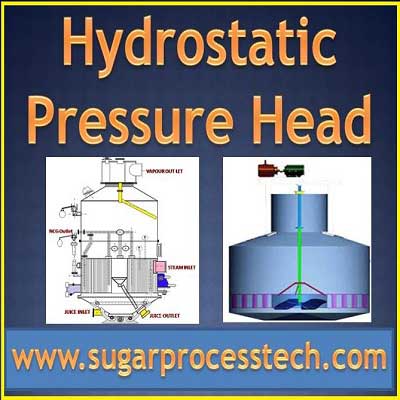This article discuss about hydrostatic pressure definition and its calculation and also hydrostatic head in robert type evaporator bodies and vacuum pans
Hydrostatic Head in Evaporator Bodies and Vacuum Pans
Hydrostatic pressure head definition
When a pressure ” P” is exerted on the surface of a liquid, the pressure to which the molecules of the liquid are subjected at a certain depth in the liquid is equal to “P ” increased by the pressure of liquid corresponding to the depth.
Since the boiling point increases with the pressure, if the temperature of the liquid corresponds to that necessary to produce boiling at the surface, this boiling would increase in the liquid layers situated at a certain depth.
Hydrostatic pressure calculation
The increase in hydrostatic pressure can be calculated by multiplying depth of liquid column by the density of the liquid.
Hydrostatic pressure in a liquid calculated as follows
P = ρ g H
Here P = pressure in liquid – It is measured in meter of water column (mwc) or bar or atm or N/m2 or PSI or lb/ft2 or kg/cm2
ρ = density of liquid – It is measured in kg/m3 or gm/ml or lb/ft3
g = acceleration of gravity – Its value is 9.81 m/sec2 or 32.17405 ft/sec2
H = Depth in the fluid where pressure is measured or height of fluid column – It is measure in meter or feet
For Unit Conversion Factors please go through the below link
Hydrostatic pressure in a water column where pressure is measured or height of fluid column –
(Density of water 1gm/ml or 1000 kg/m3 )
| Height of Water Column in meters | Pressure in bar | Pressure in psi |
| 1 | 0.098 | 1.42 |
| 2 | 0.196 | 2.85 |
| 3 | 0.294 | 4.27 |
| 4 | 0.392 | 5.69 |
| 5 | 0.491 | 7.11 |
| 6 | 0.589 | 8.54 |
| 7 | 0.687 | 10 |
| 8 | 0.785 | 11.4 |
| 9 | 0.883 | 12.8 |
| 10 | 0.981 | 14.2 |
| 12 | 1.18 | 17.1 |
| 14 | 1.37 | 19.9 |
| 16 | 1.57 | 22.8 |
| 18 | 1.77 | 25.6 |
| 20 | 1.96 | 28.5 |
Hydrostatic pressure in evaporator or Hydrosatic head in Robert evaporator bodies
In a vessel of a multiple effect evaporator, the layer of juice which is situated at the level of the bottom tube plate will be subject to a hydrostatic pressure equal to the pressure of juice which lies above it.
If, for example, the hydrostatic level of the juice in the vessel corresponds to one-third of the height of the tubes, this layer will boil at a temperature corresponding to the vapour pressure in the vessel increased by the hydrostatic pressure to which it is subjected.
As per Peter Rein
In the evaporator bodies, the average liquid boiling temperature should be evaluated at the average depth of liquid, which is 0.5 x h
where h is the boiling liquid level in meters
i.e. at a pressure Ph related to the pressure in the vapor space Pv and the liquid density by ρL
Ph = Pv + 0.5 ρL x g x H
The optimum level is expected in Robert evaporator bodies of tube length of two meters is about 33% of the tube from the bottom.
In semi-kestner type evaporator bodies, the juice level maintained around 20% of the tube length
A significant advantage in falling film evaporators is the absence of a hydrostatic head effect on evaporation.
Hydrostatic head in vacuum pan
This hydrostatic head has pronounced effect in the boiling of massecuite as the brix of material or density goes on increasing progressively in boiling and it plays a vital role as the boiling point of massecuite increases with hydrostatic pressure.
The high hydrostatic head raises the boiling point of massecuite in contact with heating surface particularly in the massecuite of lower portions of the calendria.
So hydrostatic head plays key role on messecuite level (strike height) on the above tube plate.
The boiling massecuite, at a temperature of 80 to 90 0C (175 0F to 195 0F), has a specific gravity
of about 1.47 gm/ml, (density of approximately 92 lb/ft3 ) The pressure in the massecuite will
therefore increase by about 0.15 kg/cm2 per meter (0.64 per foot) of depth.
Related Articles:
Plate type heat exchange design criteria | Plate heat exchanger heat transfer area calculation
Types of cooling towers, formula for cooling tower efficiency
Pan Section Capacity Calculation in Sugar Industry
Calculation for C massecuite dropping purity | Sugar Technology

1 thought on “Hydrostatic Pressure in evaporator bodies | Hydrostatic Head in Vacuum pans”
Sushil Kumar Singh
(June 25, 2024 - 11:14 am)Pleaseshare evaporator design for standalone refinery plant.